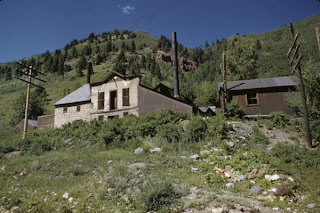Thursday, September 8, 2011
Monument Storm, Jan. 4, 1916
Tuesday, September 6, 2011
Telluride I recall as a youngster
Al Bachman, photographer.
View of an abandoned brewery in Telluride (San Miguel County), Colorado. The wood, stone, plaster and tin building has a false front and asmokestack. A corrugated tin buildings is nearby. Photo created 1963. Western History/Genealogy Dept., Denver Public Library.
Al Bachman, photographer.
View of a brick theater in Telluride (San Miguel County), Colorado. The building has a stepped parapet, a projecting enclosed balcony with a tile roof and a hip roof tile porch. Lamp posts are near the theater and a sign on the building reads: "Opera House, Picture Shows Every Evening, Admission 10 and 15 Cents." A sign projecting from the building reads: "Show." Photo created 1954. Western History/Genealogy Dept., Denver Public Library.
Monday, September 5, 2011
Hard Time in Wyoming Territorial Prison
Teachout Ranch in Northern El Paso County
A view of Teachout's Ranch near Edgerton, Colorado, includes a two-story gable-roofed building with a porch with Victorian decorative woodwork, and a smaller building nearby; numerous people stand near a board fence in front, including a seated elderly woman, a child holding a doll, a woman and child each on horseback, a seated man holding a rifle, and what appear to be ranch hands. Two wagons are in front of the fence. One is covered and is pulled by two horses with a man next to the horses. The other, also pulled by two horses is uncovered and has a man at the reins. Trees, another fence, and fields are in the background.
Western History/Genealogy Dept., Denver Public Library.
Historical Byers-Evans House in Denver





Built for William N. Byers in 1883, the stately Italianate-style home reflected its owner’s standing in the community. Byers printed Denver’s first newspaper, the Rocky Mountain News, on April 23, 1859. As editor, Byers used his paper pulpit to promote Denver and the surrounding region.
Byers became close friends with John Evans, Colorado’s second territorial governor. These men - along with their wives Elizabeth Byers and Margaret Evans - played pivotal roles in Denver’s early growth by helping to establish religious, educational, legal, and social institutions.
William G. Evans, the oldest son of former governor John Evans, bought the home in 1889. William and his wife Cornelia moved in with their two young children, John and Josephine. During the next five years, daughters Margaret and Katharine were born. An important business and civic leader in his own right, William headed the Denver Tramway Company and helped develop the Moffat Tunnel. Piercing the Continental Divide, the 6.2 mile tunnel culminated efforts to link Denver to Colorado’s western slope and solidified the city’s place as the region’s commercial hub.














